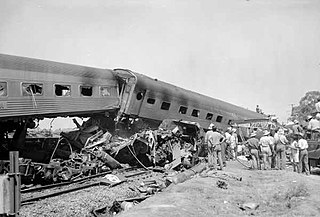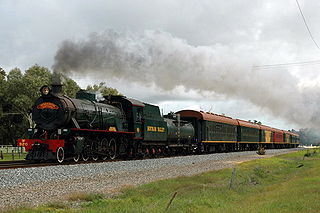| Hines Hill train collision | |
|---|---|
| Details | |
| Date | 14 January 1996 |
| Location | Hines Hill, Western Australia |
| Country | Australia |
| Operator | National Rail Corporation |
| Incident type | Collision |
| Cause | Signal passed at danger |
| Statistics | |
| Trains | 2 |
| Deaths | 2 |
The Hines Hill train collision occurred on the Eastern Goldfields Railway on 14 January 1996 at Hines Hill, Western Australia. Two trains entered a passing loop simultaneously in opposing directions, although signals at the end of the passing loop were correctly showing red for stop.
The trains involved were National Rail Corporation's 5SP5 intermodal Sydney to Perth freighter, and Westrail's 7025 Perth to Kalgoorlie freighter. [1]
The National Rail train in one direction misjudged the stop, and went past the red signal, hitting the last wagons of the Westrail train. These wagons were tankers containing diesel which burst into flames, destroying the train data recorders that might have explained what speed the train was travelling at. [2] Locomotive AN10 was derailed. [2] The driver and a teenage guest passenger were killed. Another person received severe injuries. [3] National Rail locomotives AN10 and DL37 were written off due to being damaged beyond repair. [4] A relay control room which was close to the fire was also destroyed. [2]
The collision happened at night, and there were no distance boards which might have helped the driver of the NR train judge the distance to the stop signal showing red.[ citation needed ]
In June 1998, Westrail was fined $95,000 with $85,000 in costs. [2] An appeal heard in the Supreme Court of Western Australia set aside the original conviction and Westrail was awarded $23,000 in costs. [2]
The signalling was later altered to prevent trains entering the passing loop simultaneously.
The collision illustrates the hazard of having passing loops only just long enough to hold the two trains. If the loop had been longer, the safety distance from the red departure signal to the fouling point with the arriving train would have been larger and the other train would have cleared the single line section, so avoiding the collision by some vital seconds.
Since the collision, the passing loop at Hines Hill has been lengthened for longer 1,800 m trains. The loop is now 2,304 m long, which is considerably longer than the normal longest train. The extra distance provides both a safety margin and allows a train entering the loop to clear the single line at a higher speed. It is not known if the simultaneous arrival signalling has been restored.

The Indian Pacific is a weekly experiential tourism-oriented passenger train service that runs in Australia's east–west rail corridor between Sydney, on the shore of the Pacific Ocean, and Perth, on the shore of the Indian Ocean – thus, like its counterpart in the north–south corridor, The Ghan, one of the few truly transcontinental trains in the world. It first ran in 1970 after the completion of gauge conversion projects in South Australia and Western Australia, enabling for the first time a cross-continental rail journey that did not have a break of gauge.
The Train Protection & Warning System (TPWS) is a train protection system used throughout the British passenger main-line railway network, and in Victoria, Australia.

The Violet Town rail accident, also known as the Southern Aurora disaster, was a railway accident that occurred on 7 February 1969 following the incapacitation of the driver of one of the trains, near the McDiarmids Road crossing, approximately 1 km south of Violet Town, Victoria, Australia. The crash resulted in nine deaths and 117 injuries.

The Glenbrook rail accident occurred on 2 December 1999 at 8:22 am on a curve east of Glenbrook railway station on the CityRail network between Glenbrook and Lapstone, in the Blue Mountains of New South Wales, Australia. Seven passengers were killed and 51 passengers were taken to hospital with injuries when a CityRail electric interurban train collided with the rear wagon of the long-haul Perth-to-Sydney Indian Pacific.
The Fremantle line is a suburban railway and service in Western Australia that connects the central business district (CBD) of Perth with Fremantle.

A passing loop or passing siding is a place on a single line railway or tramway, often located at or near a station, where trains or trams travelling in opposite directions can pass each other. Trains/trams going in the same direction can also overtake, provided that the signalling arrangement allows it. A passing loop is double-ended and connected to the main track at both ends, though a dead end siding known as a refuge siding, which is much less convenient, can be used. A similar arrangement is used on the gauntlet track of cable railways and funiculars, and in passing places on single-track roads.

The Zanthus train collision occurred at a crossing loop on the Trans-Australian Railway between Perth and Sydney on 18 August 1999. It is located 739 km (459 mi) east northeast of Perth and 202 km (126 mi) east of Kalgoorlie in Western Australia, on the Nullarbor Plain.

The Eastern Railway is the main railway route between Fremantle and Northam in Western Australia. It opened in stages between 1881 and 1893. The line continues east to Kalgoorlie as the Eastern Goldfields Railway.

The Prospector is a rural passenger train service in Western Australia operated by Transwa between East Perth and Kalgoorlie. On this service, two trains depart almost at the same time in opposite directions, one travelling between East Perth and Kalgoorlie, and the other between Kalgoorlie and East Perth. The original vehicles ordered in 1968 for trains providing this service were replaced in 2004 with vehicles capable of reducing journey times to 6 hours 45 minutes.

Australian Railroad Group (ARG) was an Australian rail freight operator. It began operations in Western Australia on 17 December 2000 following its purchase of the Westrail freight business. It was purchased by QR National in June 2006. The main commodities hauled by ARG included grain, mineral sands, alumina, bauxite, coal, woodchips, quartz, nickel and iron ore around Western Australia. In June 2011, it ceased trading as a separate brand, and became part of QR National.

The Hotham Valley Tourist Railway is a tourist and heritage railway in the Peel region of Western Australia.

Western Australian Government Railways (WAGR) was the state owned operator of railways in the state of Western Australia between October 1890 and June 2003. Owned by the state government, it was renamed a number of times to reflect extra responsibility for tram and ferry operations that it assumed and later relinquished. Westrail was the trading name of the WAGR from September 1975 until December 2000, when the WAGR's freight division and the Westrail brand were privatised. Its freight operations were privatised in December 2000, with all remaining passenger operations transferred to the Public Transport Authority in July 2003.

Torquay railway station is on the Riviera Line and serves the seaside resort of Torquay, Devon, England. It is 219 miles 79 chains (354 km) from London Paddington.

Railways in Western Australia were developed in the 19th century both by the Government of Western Australia and a number of private companies. Today passenger rail services are controlled by the Public Transport Authority through Transperth, which operates public transport in Perth, and Transwa, which operates country passenger services. Journey Beyond operates the Indian Pacific.

The AN class is a class of diesel locomotives built by Clyde Engineering, Somerton for Australian National in 1992–1993.
The railways of New South Wales, Australia have had many incidents and accidents since their formation in 1831. There are close to 1000 names associated with rail-related deaths in NSW on the walls of the Australian Railway Monument in Werris Creek. Those killed were all employees of various NSW railways. The details below include deaths of employees and the general public.

The Bennett Brook Railway is a 2 ft narrow gauge tourist oriented railway operated by the West Australian Light Railway Preservation Association and is located within the boundaries of Whiteman Park, 19 kilometres (12 mi) from Perth.

The GT46C is a model of diesel-electric locomotive designed and built by Clyde Engineering using Electro-Motive Diesel components. A number of Australian rail freight operators purchased them from 1997: Westrail as the Q class, FreightLink as the FQ class, and Freight Australia as the single-locomotive V class. As of 2022, all 24 locomotives were owned by Aurizon following its purchase of certain One Rail Australia assets in July 2022.
The Knowle and Dorridge rail crash was a fatal rail crash that occurred at Dorridge railway station in Warwickshire, England, on 15 August 1963. Three people died in the crash after a signalman's error routed a small freight train into the path of an express passenger train which slowed but could not stop before colliding with it.
This article is concerned with railway accidents occurring in Western Australia, where they are identified as fatal accidents, injury related accidents, or where infrastructure or rolling stock was damaged.